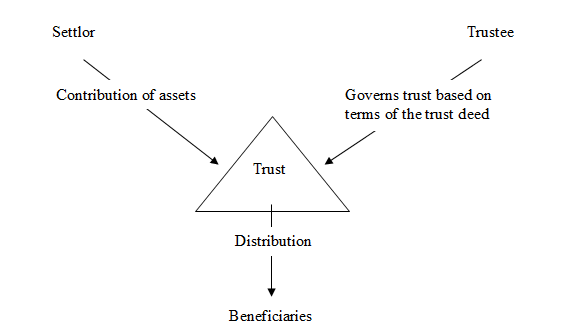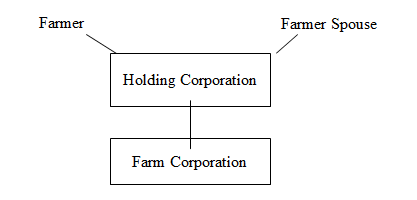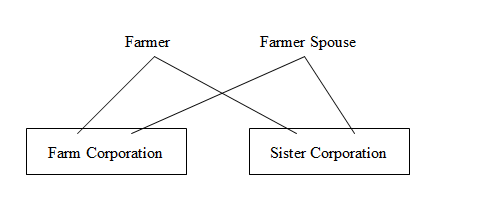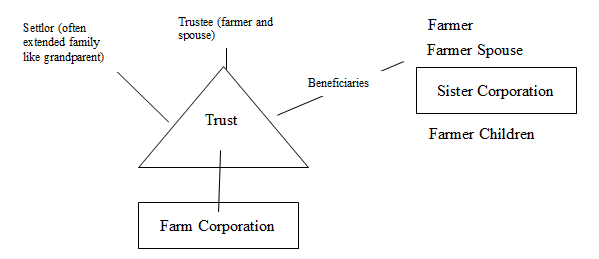| | Trusts- Basic Concept |Taxation of Trusts | Uses of Trusts | Spousal Trust | Farm Purification | Strategic Philanthropy | Alter Ego Trust | Conclusion
.
Trusts can be a valuable planning tool for the transition and management of family farming operations. Given the right circumstances and facts a well structured trust can provide for a number of advantages in farm tax, succession, and business planning.
In order for trusts to be successful it is important to understand how they work and how they can fit into your long term planning.
Trusts – Basic Concept
A trust is not a separate person or entity like a corporation, it is a legal relationship. The relationship is one in which property is held by one party for the benefit of another.
A trust relationship is created when a settlor transfers property to a trustee (person, company, or public body) to be held for the benefit of the beneficiaries. Generally, a trust deed drafted by a lawyer based on the wishes of the settlor will define the terms of the trust; however legislation and the common law can have an impact.
A trust will have a trustee that has legal title to the trust’s property, while the beneficiaries have beneficial ownership of the trust property. There is a separation of control and ownership in a trust, the trustee is the legal owner and the beneficiaries are eventually entitled to the property based on terms the trust deed. The trustee has a fiduciary duty to the beneficiaries.

Taxation of Trusts
A trust is considered to be a separate taxpayer for tax purposes. It is the trustee’s responsibility to ensure that a tax return is filed for the trust every year.
A settlor is generally deemed to have sold property at fair market value when they transfer it into a trust. As a result if the property has increased in value since the settlor acquired the property, the settlor is subject to tax on the capital gain. If the gain is eligible for the capital gains deduction it can minimize the tax consequences and increase the cost base of the property held by the trust.
A testamentary trust is a trust that is created upon the death of an individual. A testamentary trust can be created through a will or as a result of a person passing away intestacy (without a will). An inter vivos trust is a trust that is created during the lifetime of the person (the settlor) who creates the trust.
The taxation of trusts depends on the type of trust filing the tax return. Income retained in a testamentary trust, for its first 36 months, is taxed at the graduated rates of tax like a person, with certain limitations on tax credits available. Income retained in an inter vivos trust is taxed at the highest marginal tax rate: 48% per cent in Alberta (2017 tax rates).
If the trust is a qualifying trust, it has the ability to transfer the property out to its beneficiaries on a tax-deferred basis. A trust is deemed to have sold all of its assets every 21 years, thus giving rise to tax on any capital gains in the trust unless the trust is wound up beforehand. The 21 year rule does not apply to spousal trusts and alter ego trusts.
For example, suppose a farmer put the shares of his family farm corporation into a trust when the value of the shares were $100,000 and had the trust hold the shares for 21 years. On the 21st year the shares have a fair market value of $1,000,000. The gain the trust would have to pay tax on in the 21st year would be $900,000. This gain can be allocated to the beneficiaries of the trust and have each beneficiary taxed on their portion of the gain based on the allocation (the beneficiaries may be able to use their capital gain exemption on this gain allocated).
There are many other types of trusts; each has its own tax rules. Legal and tax advice is recommended when creating a trust to ensure that the appropriate tax consequences are planned for.
Uses of Trusts
Trusts have been used in a wide variety of situations, for a wide variety of reasons.
1) Tax planning:
Income splitting – graduated tax rates in Canada mean that the rate of tax increases as your income increases, a trust provides an opportunity to share income that would otherwise be taxed at the high rate in the hands of a farmer, with their spouse or children.
Reducing capital gains on death – as a result of farm property being held in a trust, the assets are no longer required to be reported on the final return of an individual on death.
Multiplication of the capital gains exemption – have the shares of a family farm corporation or qualified farm property owned by a trust whose beneficiaries are the farmer, their spouse and children. Then the capital gain in the trust on the sale of the family farm corporation shares or property can be allocated to each of the beneficiaries to claim their capital gains exemption.
An example of this would be if farm land was owned by a trust. The trust’s beneficiaries include the farmer, their spouse, and two children. None of the individuals have ever used their $1,000,000 capital gains exemption. The farm land had a cost base of $500,000 when it was put into the trust by the farmer. An offer has been made to purchase the land for $4,500,000. As a result the total gain on the farm land is $4,000,000.
If the farmer were to have just held the land personally the tax would be calculated as follows: (Note: 2017 Alberta Tax Rates)
Proceeds of Disposition: $4,500,000
Adjusted Cost Base: $ 500,000
Capital Gain: $4,000,000
Capital Gains Exemption: $1,000,000
Remaining Capital Gain: $3,000,000
Taxable Capital Gain (50% of Capital Gain): $1,500,000
Tax at Highest Marginal Rate (48% AB): $ 720,000
If the farmer were to have put the land in a trust, the trust would allocate the gain to each beneficiary:
Proceeds of Disposition: $4,500,000
Adjusted Cost Base: $ 500,000
Capital Gain: $4,000,000
Capital Gains Exemption (Farmer): $1,000,000
Capital Gains Exemption (Spouse): $1,000,000
Capital Gains Exemption (Child #1): $1,000,000
Capital Gains Exemption (Child #2): $1,000,000
Remaining Capital Gain: $ 0
Taxable Capital Gain (50% of Capital Gain): $ 0
Tax at Highest Marginal Rate (39% AB): $ 0
In this example, you can see that by holding the farm land in a trust and utilizing 4 capital gain exemptions, we were able to save $720,000 assuming the highest marginal tax rate on the sale (we have ignored any potential alternative minimum tax that may arise in the beneficiaries’ hands).
2) Creditor protection:
A discretionary trust can be a useful tool in protecting assets from creditors as the beneficiaries do not own property in the trust and as a result creditors of the beneficiary may have no claim against the trust assets. The property in the trust also does not belong to the trustee and cannot be claimed by the trustee’s creditors.
3) Matrimonial property claims:
Discretionary trusts are also effective in protecting assets in the event of marriage breakdown. In a situation where parents want farm land to transfer to their child but are concerned about the child’s marriage, a trust can be used to protect the farm land from a matrimonial claim. The land can be transferred to a trust for the benefit of the child (and other beneficiaries), however since the child would have no interest in the property it would not normally be considered matrimonial property.
4) Confidentiality:
Unlike a will, which becomes a matter of public record, the names of a beneficiary of a trust do not need to be disclosed as the trustee transacts business in the name of the trustees or in the name of the trust.
5) Flexibility:
With a discretionary trust, the trustee can be given the discretion to determine which beneficiary receives the farm property and when they receive it.
A farming couple’s will can provide that the farm and non-farm assets are held on trust for the benefit of all of their children, until the youngest child attains the age of 21 years. It is up to the trustee’s discretion to decide which child or children receives the farmland, and what assets are passed to the non-farming child or children. In the event that one child is actively farming, they can receive the farm assets, while those not actively farming can receive the non-farm assets.
It should be noted that this type of trust arrangement would likely not qualify for the farm rollover if the land does not vest indefeasibly in the name of the children within 36 months of the death of the farming parent (settlor).
6) Protection of beneficiaries:
For certain beneficiaries that are not capable of managing property it may be desirable to separate legal ownership from beneficial ownership. The beneficiary may be too young or mentally incapable of transacting appropriately if the property were in their possession.
As an example farm land could be held in trust for a handicapped child for life, with the income generated on the farm land being paid to the child annually. On the death of the handicapped child, the land can be transferred out of the trust to the other children and/or grandchildren.
Many parents are not comfortable allowing for a child 18 years of age to receive a share of an estate. Implementing a trust can delay transfer to the beneficiary to a future date, when the child reaches the age of 21, 35, or 50. If the child dies before the age specified, the trust can specify that it be transferred to other beneficiaries. Again, in these types of scenarios there maybe issues with the farm rollover rules but perhaps these issues do not outweigh the other concerns regarding the beneficiaries.
The Spousal Trust
An excellent example of the usefulness of trust is the spousal trust. Historically, spousal trusts have only been used when the surviving spouse may not have the ability to manage trust assets appropriately. The deceased spouse would set up a spousal trust so a trustee could manage the trust assets in accordance with their wishes. Today it is generally assumed that the surviving spouse will make the absolute gift of the entire estate to whoever is more appropriate. The surviving spouse will have access to a vast array of resources and advisors to help with managing the trust assets and in completing the couple’s wishes on the ultimate gift of the entire estate. However, there are a number of scenarios where the use of a spousal trust is desirable:
The Second Marriage
If the entire estate is left absolutely to the surviving spouse, there is no guarantee that on the death of the surviving spouse, the assets will be left to the children of the first marriage. The spousal trust allows the assets to be held for the life of the second spouse with all of the income paid to the spouse during their life. There is usually a power given to the trustees to encroach on the capital in the event the income is not sufficient or in case unusual circumstances arise. On the death of the spouse, the amount remaining in the trust can be transferred to the children of the first marriage. This is particularly useful in family farming scenarios to ensure that the farm passes to the farming child from the first marriage.
Spendthrift Spouse
If a non-farming spouse is a compulsive spender, and the farming spouse would like to support them after their death a spousal trust can be useful. If the farming spouse leaves farm land in a spousal trust, the income from the land can be given to the non-farming spouse, but they will not have the ability to sell or mortgage the land to gain access to additional cash for their spending habits. Only the trustee is the legal owner, and therefore only the trustee can sell or mortgage the land.
Trust and Medical Conditions
If the deceased spouse does not trust the surviving spouse to leave the farm to the farming child or the spouse is incapacitated due to a medical condition, a spousal trust ensures that the land passes to the farming child upon the death of the surviving spouse. The trust could provide that the farming child be allowed to rent the land at fair market rent for the life of the spouse and that the land then be transferred to the child on the death of the spouse.
Farm Purification
In the operations of a successful farm corporation, excess cash not needed for the operations is often used to purchase non-farming assets (for example investments). As a result of the buildup of non-farm assets the corporation no longer qualifies for the farm rollover rules.
Often times in order to solve this, a holding company is set up to ensure that these assets can be removed from the farming corporation and put into the holding company.

The concern with this structure is that if the Farm Corporation were to ever be sold, it would be sold by the holding corporation and not the farmer and his spouse individually. As a result of this the holding corporation will have to pay tax on the capital gains on the increase in value on the shares of the farm corporation. If the shares were to be owned by the farmer and his spouse personally they would each have access to their $1,000,000 lifetime capital gains exemptions to shelter some of the gains from tax.
Another concern is the rollover rules and the issue that the holding company shares cannot rollover to children. If this is the case, how do we pass the farming operations on to the next generation?
Another solution to avoid the loss of the capital gains exemption or ability to rollover is to remove the non-farm assets from the farm corporation into a sister corporation.

The concern with this structure is that it becomes difficult to continually move the accumulated cash and other assets from the farm corporation to the sister corporation.
A solution to this purification issue can be to use a trust in the middle strategy.

In this situation when the farm corporation accumulates non-farming assets they can be moved to the trust, from the trust the non-farming assets can be moved to the beneficiaries. This leaves room to move the funds into the sister corporation or to any other beneficiary should it make sense to do so. This strategy also gives rise to the ability to multiply capital gains exemptions should the farm corporation ever be sold.
Strategic Philanthropy
A trust can assist in making tax efficient charitable donations. An individual can put cash, securities, or real estate aside for a charity. The income from the property will continue to be that of the individual until their death. At death the assets are transferred to the charity. When the trust is set up, an actuary can estimate the value of the charity’s residual interest in the trust and the donor gets a tax receipt for that amount. The terms of the trust will need to outline that the individual cannot encroach on the capital component of the trust, and only have access to the income generated from the assets.
An example could be a farmer transferring $500,000 of land into a charitable remainder trust while having a charitable organization as the beneficiary. An actuary would determine the value of the donation receipt after looking at the farmer’s age, appropriate discount rate, and actuarial tables.
Alter Ego Trust
An alter ego trust is a trust that is set up during the lifetime of an individual who is at least 65 years of age. Generally, these types of trusts are used when an individual is concerned about the possibility of losing their capacity to deal with their assets.
The alter ego trust allows a person to currently place assets in a trust without incurring an immediate tax liability. In the event that the individual later becomes incapacitated, the trust document would designate who is to administer the asset and how they are to be used. The trust would specify who would receive the assets upon the death of the individual.
The individual setting up the alter ego trust must be entitled to all the income of the trust before his or her death. No individual may receive any income or capital of the trust before the death of the individual who set up the trust.
For farm land or other qualifying farm property going into an alter ego trust you need to consider that the property cannot qualify for the rollover rules.
Conclusion
The use of trusts in farm business structuring can be helpful in providing for tax planning, creditor protection, succession planning, and farm purification. Each of the strategies discussed are general outlines for when a trust could be useful. Each individual farmer’s situation is unique and appropriate planning should be made for those circumstances. A farmer would want to discuss their specific goals and future plans before making any decisions on the use of a trust. If one farmer has intentions of selling their farm and another intends on passing the farm along to their children they may have very different planning needs.
The use of trusts in farm business structuring results in complexity of operations and a farmer should consider if the benefits of the structure are worth the additional costs and complexities.
Trusts can be a very useful tool in farm estate planning given proper planning and utilization. It is always prudent to speak to your financial advisor prior to making any decisions to ensure your operations will be adequately protected.
Developed by:
Colin Miller, CA, KPMG LLP Lethbridge
Joel Bokenfohr, Alberta Agriculture and Forestry |
|